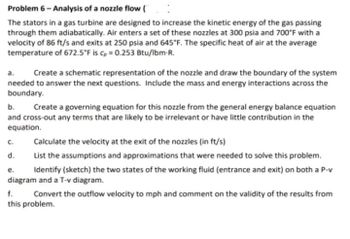
Elements Of Electromagnetics
7th Edition
ISBN: 9780190698614
Author: Sadiku, Matthew N. O.
Publisher: Oxford University Press
expand_more
expand_more
format_list_bulleted
Question
Only solve d e and f

Transcribed Image Text::
Problem 6- Analysis of a nozzle flow (
The stators in a gas turbine are designed to increase the kinetic energy of the gas passing
through them adiabatically. Air enters a set of these nozzles at 300 psia and 700°F with a
velocity of 86 ft/s and exits at 250 psia and 645°F. The specific heat of air at the average
temperature of 672.5°F is cp = 0.253 Btu/lbm-R.
a. Create a schematic representation of the nozzle and draw the boundary of the system
needed to answer the next questions. Include the mass and energy interactions across the
boundary.
b.
Create a governing equation for this nozzle from the general energy balance equation
and cross-out any terms that are likely to be irrelevant or have little contribution in the
equation.
C.
Calculate the velocity at the exit of the nozzles (in ft/s)
d.
List the assumptions and approximations that were needed to solve this problem.
Identify (sketch) the two states of the working fluid (entrance and exit) on both a P-v
diagram and a T-v diagram.
e.
f.
Convert the outflow velocity to mph and comment on the validity of the results from
this problem.
Expert Solution
This question has been solved!
Explore an expertly crafted, step-by-step solution for a thorough understanding of key concepts.
This is a popular solution
Trending nowThis is a popular solution!
Step by stepSolved in 4 steps with 6 images

Knowledge Booster
Learn more about
Need a deep-dive on the concept behind this application? Look no further. Learn more about this topic, mechanical-engineering and related others by exploring similar questions and additional content below.Similar questions
- The two gears in the picture below on the left are meshing together. The two gears in the picture on the right are stuck together and are on the same shaft. Which of these statements is true when the gears are turning? (There may be more than one correct answer). A. The two meshing gears have the same |?| B. The two gears on the same shaft have the same |?| C. The two meshing gears turn through the same magnitude of arc-length in the same time D. The two gears on the same shaft turn through the same magnitude of arc-length in the same timearrow_forward42 in 64 [in]- 50 in D 59 in B این دو سال است اند اما او شده از این سامانه 63 in -10 in 21 in ( Given: The plate( The shaded rectangular volume) has weighs 240 lbf. It is. suspended bycable CD, Which D is wall anchor. So, Find the magnitude of force in the cable CD such the system is in static equilibrium??. Show all works.arrow_forwardDetermine the horizontal and vertical stroke of a slider D and F when crank AB rotates 30degrees sideways. AB=20, BC=25, CD=30, BD=50, CF=45cm. Draw in appropriate scale.arrow_forward
arrow_back_ios
arrow_forward_ios
Recommended textbooks for you
 Elements Of ElectromagneticsMechanical EngineeringISBN:9780190698614Author:Sadiku, Matthew N. O.Publisher:Oxford University Press
Elements Of ElectromagneticsMechanical EngineeringISBN:9780190698614Author:Sadiku, Matthew N. O.Publisher:Oxford University Press Mechanics of Materials (10th Edition)Mechanical EngineeringISBN:9780134319650Author:Russell C. HibbelerPublisher:PEARSON
Mechanics of Materials (10th Edition)Mechanical EngineeringISBN:9780134319650Author:Russell C. HibbelerPublisher:PEARSON Thermodynamics: An Engineering ApproachMechanical EngineeringISBN:9781259822674Author:Yunus A. Cengel Dr., Michael A. BolesPublisher:McGraw-Hill Education
Thermodynamics: An Engineering ApproachMechanical EngineeringISBN:9781259822674Author:Yunus A. Cengel Dr., Michael A. BolesPublisher:McGraw-Hill Education Control Systems EngineeringMechanical EngineeringISBN:9781118170519Author:Norman S. NisePublisher:WILEY
Control Systems EngineeringMechanical EngineeringISBN:9781118170519Author:Norman S. NisePublisher:WILEY Mechanics of Materials (MindTap Course List)Mechanical EngineeringISBN:9781337093347Author:Barry J. Goodno, James M. GerePublisher:Cengage Learning
Mechanics of Materials (MindTap Course List)Mechanical EngineeringISBN:9781337093347Author:Barry J. Goodno, James M. GerePublisher:Cengage Learning Engineering Mechanics: StaticsMechanical EngineeringISBN:9781118807330Author:James L. Meriam, L. G. Kraige, J. N. BoltonPublisher:WILEY
Engineering Mechanics: StaticsMechanical EngineeringISBN:9781118807330Author:James L. Meriam, L. G. Kraige, J. N. BoltonPublisher:WILEY

Elements Of Electromagnetics
Mechanical Engineering
ISBN:9780190698614
Author:Sadiku, Matthew N. O.
Publisher:Oxford University Press

Mechanics of Materials (10th Edition)
Mechanical Engineering
ISBN:9780134319650
Author:Russell C. Hibbeler
Publisher:PEARSON

Thermodynamics: An Engineering Approach
Mechanical Engineering
ISBN:9781259822674
Author:Yunus A. Cengel Dr., Michael A. Boles
Publisher:McGraw-Hill Education

Control Systems Engineering
Mechanical Engineering
ISBN:9781118170519
Author:Norman S. Nise
Publisher:WILEY

Mechanics of Materials (MindTap Course List)
Mechanical Engineering
ISBN:9781337093347
Author:Barry J. Goodno, James M. Gere
Publisher:Cengage Learning

Engineering Mechanics: Statics
Mechanical Engineering
ISBN:9781118807330
Author:James L. Meriam, L. G. Kraige, J. N. Bolton
Publisher:WILEY